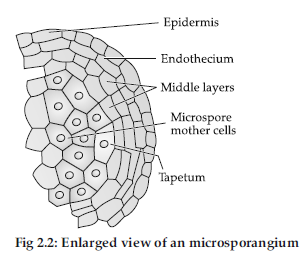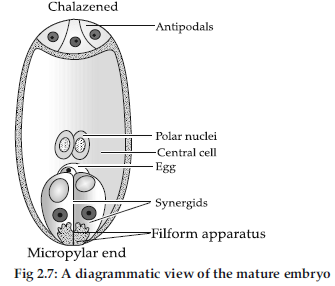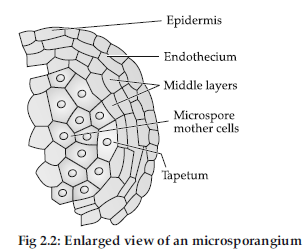VBQs Sexual Reproduction in Flowering Plants Class 12 Biology with solutions has been provided below for standard students. We have provided chapter wise VBQ for Class 12 Biology with solutions. The following Sexual Reproduction in Flowering Plants Class 12 Biology value based questions with answers will come in your exams. Students should understand the concepts and learn the solved cased based VBQs provided below. This will help you to get better marks in class 12 examinations.
Sexual Reproduction in Flowering Plants VBQs Class 12 Biology
Question. Lifespan of tortoise is
(a) 100-150 years
(b) 250 years
(c) 20 years
(d) 1 year
Answer
A
Question. Single-celled animals are said to be immortal because
(a) they grow indefinitely in size
(b) they can tolerate any degree of change in temperature
(c) they can reproduce throughout their lifespan
(d) they continue to live as their daughter cells
Answer
D
Question. Arrange the organisms shown below in the increasing order of their lifespans.
(a) Parrot < Crow < Crocodile
(b) Crow < Crocodile < Parrot
(c) Crocodile < Parrot < Crow
(d) Parrot < Crocodile < Crow
Answer
B
Question. Which of the following options is/are correct about pollination?
(a) Occurs in almost all flowering plants
(b) Facilitates pollen transfer to stigma
(c) Both (a) and (b)
(d) None of the above
Answer
C
Question. Essential and most critical event in sexual reproduction is
(a) fertilisation
(b) division in male and female gametes
(c) Both (a) and (b)
(d) None of the above
Answer
C
Question. Fusion of male and female gametes is called
(a) syngamy
(b) fertilisation
(c) Both (a) and (b)
(d) heterogamy
Answer
C
Question. Reproduction can be considered as
(a) a biological process
(b) a cycle of birth, growth and death
(c) a process that enables continuity of species
(d) All of the above
Answer
D
Question. Study the given figures and processes representing the binary fission in Amoeba.
A. Daughter cells formation
B. Enlargement of nucleus
C. Parent cell
D. Constricted cell formation
E. Minimisation of pseudopodia
Arrange the figures and processes in the correct sequence and select the correct answer.
(a) D® C® A® B® E
(b) C® D® A® B® E
(c) C® E® B® D® A
(d) D® C® B® E® A
Answer
C
Question. Asexual reproduction is a method of reproduction in which participation of ……… takes place.
(a) one individual
(b) two individuals (same species)
(c) multi-individuals
(d) two individuals (different species)
Answer
A
Question. Cell division is the mode of reproduction in
(a) monerans
(b) protists
(c) Both (a) and (b)
(d) None of the above
Answer
C
Question. Reproduction in Amoeba is carried out through
(a) gemmule formation
(b) binary fission
(c) budding
(d) plasmotomy
Answer
B
Question. Gemmule formation is a common mode of reproduction in
(a) Hydra
(b) sponge
(c) Penicillium
(d) Amoeba
Answer
B
Question. Hydra reproduces by
(a) Budding
(b) Fragmentation
(c) Gemmule formation
(d) Both (a) and (b)
Answer
D
Question. Study the following diagram and the information given below.
A. Zoospore of Chlamydomonas.
B. Conidia of Penicillium.
C. Buds in Hydra.
D. Gemmulesin sponge.
All the above are
(a) bodies involved in sexual reproduction
(b) bodies involved in asexual reproduction
(c) bodies of young ones
(d) All the above are correct
Answer
B
Question. Chances of survival of young ones are more in the case of…………. individuals.
(a) oviparous
(b) viviparous
(c) ovoviviparous
(d) None of these
Answer
B
Question. Offsprings of oviparous animals have less chances of survival as compared to those of viviparous animals because
(a) proper embryonic care and protection is absent
(b) embryo does not develop completely
(c) progenies are of smaller size
(d) genetic variations do not occur
Answer
A
Question. Refer the given figures which show three different types of fission.
A. Longitudinal fission
B. Transverse fission
C. Multiple fission
Select the option which correctly matches them with the organism in which they occur.
A B C
(a) Euglena Plasmodium Amoeba
(b) Plasmodium Paramecium Euglena
(c) Euglena Paramecium Escherichia
(d) Euglena Paramecium Amoeba
Answer
D
Question. Offsets are produced by NEET 2018
(a) parthenocarpy
(b) mitotic divisions
(c) meiotic divisions
(d) parthenogenesis
Answer
C
Question. Refer to the given figures and identify X and Y in these.
(a) X–Buds, Y–Nodes
(b) X–Nodes, Y–Adventitious buds
(c) X–Nodes, Y–Adventitious roots
(d) X–Eyes, Y–Nodes
Answer
B
Question. Which one of the following is correctly matched?
(a) Onion – Bulb CBSE-AIPMT 2012
(b) Ginger – Sucker
(c) Chlamydomonas – Conidia
(d) Yeast – Zoospores
Answer
A
Question. Which of the following is not a vegetative propagule?
(a) Offset
(b) Antherozoid
(c) Rhizome
(d) Bulbil
Answer
B
Question. If a leaf cell of Agave have X chromosome, then what will be the number of chromosomes in a cell of its bulbil?
(a) 2X
(b) X
(c) X/4
(d) X/2
Answer
B
Question. Identify the plant which contains the features given below.
I. The plant was introduced in India because of its beautiful flowers and shape of leaves.
II. It can propagate vegetatively at a phenomenal rate and spread all over water body in a short period.
III. It is very difficult to get rid of these plants.
Answer
B
Question. The site of origin of the new plantlets in potato, Dahlia, ginger and banana is
(a) floral buds present on stem
(b) internodes of modified stem
(c) nodes of modified stem
(d) adventitious buds present on root
Answer
C
Question. Which one of the following options shows two plants in which new plantlets arise from the same organ?
(a) Guava and ginger
(b) Potato and sweet potato
(c) Dahlia and mint
(d) Potato and sugarcane
Answer
A
Question. Some organisms are capable of asexual or sexual reproduction. Under favourable conditions, reproduction proceeds asexually. When conditions become more stressful reproduction switches to a sexual mode. Why?
(a) Sexual reproduction is simple and more rapid allowing larger numbers of offspring to be produced
(b) Sexual reproduction requires two separate individuals, who can mutually provide nutrient support during stress
(c) Sexual reproduction produces individuals with new combinations of recombined chromosomes increasing diversity
(d) Asexual reproduction requires more energy
Answer
C
Question. The growth phase of an organism before attaining sexual maturity is referred to as
(a) juvenile phase
(b) pre-reproductive phase
(c) Both (a) and
(b) (d) None of these
Answer
C
Question. Select the correct sequence from the following.
I. Juvenile phase®Senescent phase®Reproductive phase
II. Juvenile phase®Reproductive phase®Senescent phase
III. Reproductive phase®Juvenile phase®Senescent phase
IV. Pre-reproductive phase®Reproductive phase® Senescent phase
(a) I and II
(b) I and IV
(c) III and IV
(d) II and IV
Answer
D
Question. Which one of the following flowers only once in its lifetime? NEET 2018
(a) Mango
(b) Jackfruit
(c) Bamboo species
(d) Papaya
Answer
C
Question. Strobilanthes kunthiana is also called
(a) Neelakurinji
(b) Peela kuranji
(c) Hara kuranji
(d) Kala kuranji
Answer
A
Question. Oestrus cycle is cyclic change in the activities of ovaries and accessory duct in non-primates during
(a) reproductive (seasonal) period
(b) maturation period
(c) ageing period
(d) juvenile period
Answer
A
Question.In Amoeba, under unfavourable conditions, …A…
takes place but under favourable conditions …B…occurs.
Identify A and B.
A B
(a) Sporulation Encystation
(b) Encystation Sporulation
(c) Binary fission Encystation
(d) Multiple fission Encystation
Answer
B
Question. Zoospores are
(a) motile gametes of Chlamydomonas
(b) non-motile gametes of sponges
(c) motile gametes of Hydra
(d) non-motile gametes of Penicillium
Answer
A
Very Short Answer Type Questions
Question. Draw a diagram of microspore of an angiosperm.
Label its cellular components only.
Answer :

Question. An anther with a malfunctioning tapetum often fails to produce viable male gametophytes. Give any one reason.
Answer : Because the tapetum provides nourishment for the development of pollen grains.
Question. How many microsporangia are present in a typical anther of angiosperm.
Answer : Usually Four.
Short Answer Type Questions
Question. ”Pollen grains in wheat are shed at 3-celled stage while in peas they are shed at 2-celled stage.” Explain. Where are germ pores present in a pollen grain ?
Answer : At the time of shedding wheat pollen consist of one vegetative and two male gametes (3 celled), While pea pollen consists of one vegetative and one generative cell (2 celled) Germ pores are present on the exine (Where sporopollenin is absent)
Question. Name the organic materials exine and intine of an angiosperm pollen grain are made up of.
Explain the role of exine.
Answer : The exine is made up of sporopollenin, which is one of the most resistant organic material. The intine layer is made up of cellulose and pectin materials. The exine is hard and hence protects the pollen grains during adverse conditions.
Detailed Answer :
Exine is made up of a substance called “sporopollenin” while intine is made up of pectocellulose.
Sporopollenin is a resistant fatty substance therefore, exine functions as a protective covering of pollen grain. It also possesses the proteins for enzymatic and compatibility reactions.
Question. Where is sporopollenin present in plants ? State its significance with reference to its chemical nature.
Answer : Present in exine of pollen / pollen grain Sporopollenin is the most resistant organic materials. It can withstand high temperature and strong acids and alkali. It cannot be degraded by enzymes.
Question. Mention the ploidy of the different types of cells present in the female gametophyte of an angiosperm.
Answer : Synergids = n/haploid, egg = n/haploid, polar nuclei = n/haploid, antipodals = n/haploid = ½ × 4 // all types of cell of female gemetophyte are haploid / n = 2
Question. Draw the diagram of microsporangium of an angiosperm and label any four parts. State the function of its innermost wall layer.
OR
Draw and label the enlarged view of microsporangium of an angiosperm. State the function of its innermost wall layer.
Answer :

Tapetum nourishes the developing pollen grains.
Question. (i) Describe in sequence the process of microsporogenesis in angiosperms.
(ii) Draw a labelled diagram of two celled final structure formed.
Answer : (i) The process of formation of microspores or pollen grains from microspore or pollen mother cell (MMC or PMC) by meiosis is called microsporogenesis.
It takes place in pollen sacs or microsporangia of each anther lobe.
The cells of sporogenous tissue of microsporangium functions as potential MMC/PMC in the anther. They undergo meiosis and as a result form four microspores or pollen grains arranged in tetrads. The pollen grains separate from the tetrads and give rise to two celled male gametophytes while still in situ. In the majority of angiosperms, the pollen is released from the anther at 2 celled stage while in some at 3-celled stage as the generative cell divides to form 2 male gametes.
(ii)

Question. Draw a diagram of a male gametophyte of an angiosperm. Label any four parts. Why is sporopollenin considered the most resistant material.
Answer : Diagram of male gametophyte :

Sporopollenin is considered to be the most resistant organic material because it is chemically very stable and can withstand high temperature, acidic and alkaline conditions and enzymes.
Question. (i) Do all pollen grains remain viable for the same length of time ? Support your answer with two suitable examples.
(ii) How are pollen grains stored in pollen banks ? State the purpose of storing pollen grains in banks.
Answer : (i) No
Examples :
(a) Cereals / rice / wheat – pollen grains / loose viability within thirty minutes of their release.
(b) In some members of Rosaceae / leguminosae maintain viability for months.
(ii) Using cryopreservation techniques / in liquid nitrogen (– 196º C)
Maintaining viability / preserving threatened species / preserving commercially important plants / to be used for crop breeding programmes.
Question. The embryo sac in female gametophyte is seven celled and eight nucleated structure. Justify the statement with the help of a labelled diagram.
Answer : The typical female gametophyte or embryo sac has three cells that are grouped together at the micropylar end and constitute the egg apparatus. The egg apparatus, in turn, consists of two synergids and one egg cell.
Three cells are at the chalazal end and are called the antipodals.
The large central cell has two polar nuclei.
Thus, a typical angiosperm embryo sac, at maturity is 8-nucleate is 7-celled.

Question. Explain giving reasons why pollen grains can be best preserved as fossils.
Answer : Pollen grains are best preserved as fossils because of the following reasons :
(i) The sporopollenin of exine is highly resistant to the action of strong acids and alkali and can withstand a high temperature.
(ii) It is not easily degraded by any of the enzyme known so far.
Long Answer Type Questions
Question. Explain the process of microsporogenesis in angiosperms.
Answer : Process of microsporogenesis:
(i) When the anther develops, each cell of sporogenous tissue functions as microspore mother cell (MMC) or pollen mother cell (PMC) and undergoes meiotic divisions to form microspore tetrads.
(ii) The process of formation of microspores from a pollen mother cell (PMC) through meiosis is called microsporogenesis.
(iii) The microspores get arranged in a cluster of four cells and hence are microspore tetrad.
(iv) As the anthers mature and dehydrate, the microspores dissociate from each other and develop into pollen grains.
(v) In each microsporangium, thousands of pollen grains are formed and released with the dehiscence of anther.
Question. (i) Describe the structure of a 3-celled pollen grain of an angiosperm.
(ii) Trace its development from sporogeneous tissue in the anther.
OR
Describe in sequence the events that lead to the development of a 3-celled pollen grain from a microspore mother cell in angiosperms.
OR
Describe the development of male gametophyte in angiosperms.
Answer : (i) Structure of 3-celled pollen grain :


(a) Pollen grains are normally spherical in shape.
(b) Each pollen grain has a prominent two-layered wall.
(c) The outer layer is called exine and the inner layer is called intine.
(d) Exine is hard and made up of sporopollenin.
(e) Intine is thin, and it is made up of cellulose and pectin.
(f) At certain places, exine is either absent or very thin and such places are called germ pores.
(g) A mature pollen grain has two cells – a vegetative cell and a generative cell.
(h) The vegetative cell is larger, has abundant reserve food and a large irregular-shaped nucleus.
(i) The generative cell is small and spindle shaped and it floats in the cytoplasm of vegetative cell.
It is a cell with in the cell.
(j) The generative cell in some cases divides to form two male gametes, thus making the pollen 3-celled.
(ii) Development of 3 celled pollen grain :

(a) Every cell of the sporogeneous tissue has a potential pollen mother cell (PMC) and can give rise to microspore tetrad or pollen grains.
(b) Each microspore mother cell undergoes meiosis to form a cluster of four haploid cells, called microspore tetrad.
(c) As the anther matures, the microspores dissociate from the tetrad and develop into pollen grains.
(d) The nucleus of the microspore undergoes mitosis to form a large vegetative cell or tube cells and a small spindle-shaped generative cell that floats in the cytoplasm of the vegetative cell.
(e) They develop a two-layered wall, the outer exine made of sporopollenin and the inner intine made of cellulose and pectin.
(f) Usually the pollen grains are liberated at this two-celled stage. In certain species the generative cell divides mitotically to form two male-gametes and the pollen grains are three celled during liberation.
Question. Describe the structure of microsporangium.
OR
Draw a labelled diagram of an anther lobe at microscopic-mother cell stage. Mention the roles of different wall layers of anther.
Answer : Structure of microsporangium of Pollen or Pollen sac :
(i) It is circular and is generally surrounded by wall layers namely, Epidermis, Endothecium, 2 or 3 Middle layers and Tapetum.
(ii) The first two layers perform the function of protection and help in dehiscence of anther to release the pollens.
(iii) The middle layers and the innermost layer, (tapetum) nourishes the developing pollen grains.
(iv) The cells of the tapetum possess dense cytoplasm and more than one nuclei.
(v) When the anther is young, a group of compactly arranged homogenous cells called sporogenous tissues occupies the centre of each microsporangium.

Question. (i) Describe the development of a 7-celled female gametophyte from a megaspore mother cell in an angiosperm.
(ii) What is the role of endothecium and tapetum in an anther ?
Answer : (i) Development of female gametophyte :
The female reproductive part of a flower is gynoecium, which consists of three parts— stigma, style and ovary. The ovules are formed in the ovary and attach to it through placenta. The ovule is surrounded by one to two protective layers called integuments, leaving a small opening at one end termed as a micropyle. The stalk of the ovule is called funiculus. The ovule is composed of multi celled cellular tissue called the nucellus. A hypodermal cell of nucellus at the micropylar end enlarges and becomes a megaspore mother cell that undergoes meiosis to form a linear tetrad of four megaspores.
Out of four, only one remains functional and three megaspores degenerate. The functional megaspore undergoes three successive mitotic divisions to form eight nuclei, which arrange themselves into three groups. Three nuclei migrate towards the micro-pylar end and form the egg apparatus. Other three nuclei form antipodal cells at chalazal end. The remaining two nuclei come together as polar nuclei which fuse to form secondary nucleus in the centre of the embryo sac.
(ii) Role of endothecium : Endothecium performs the function of protection and helps in dehiscence of anther to release the pollen.
Role of tapetum : It nourishes the developing pollen grains.